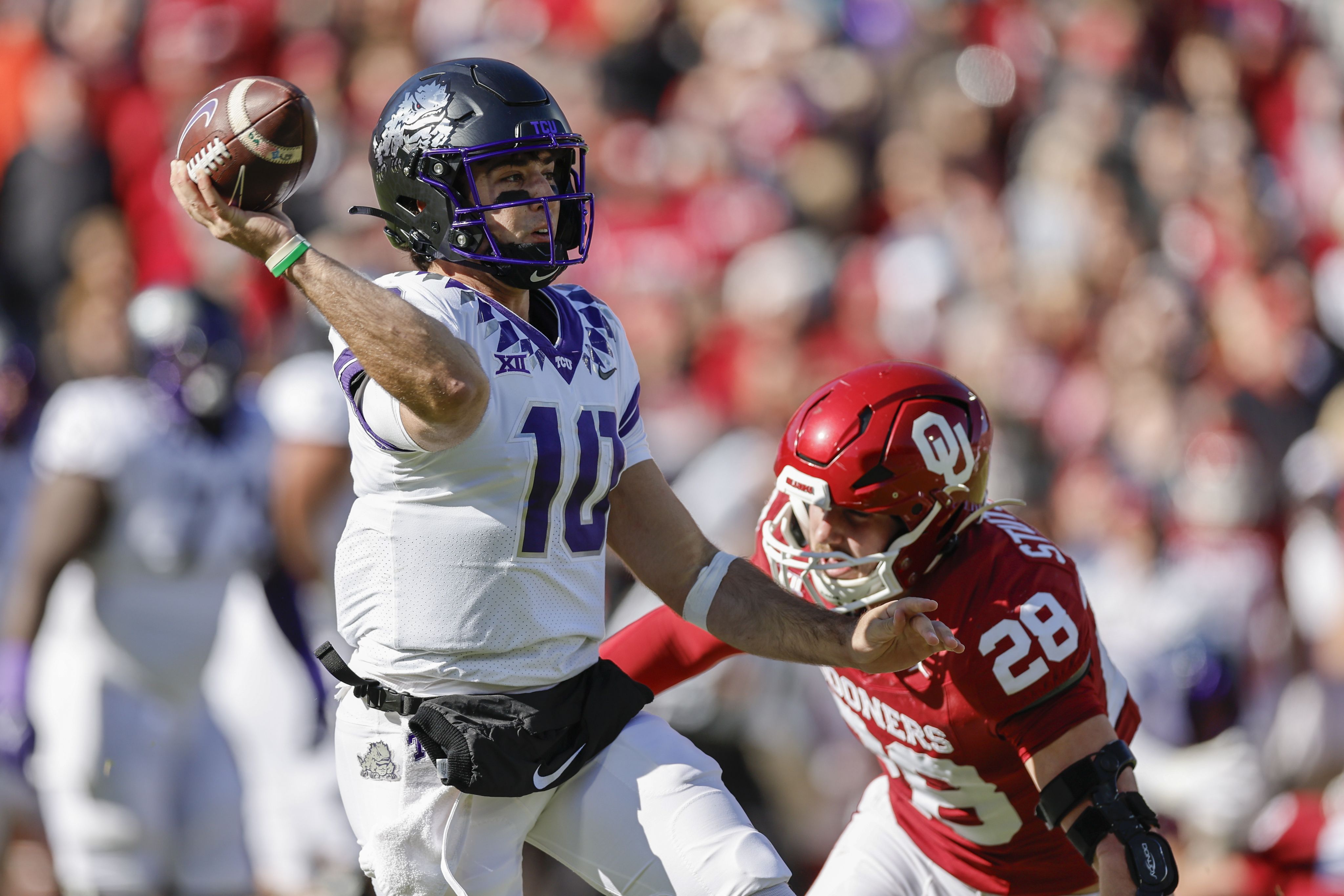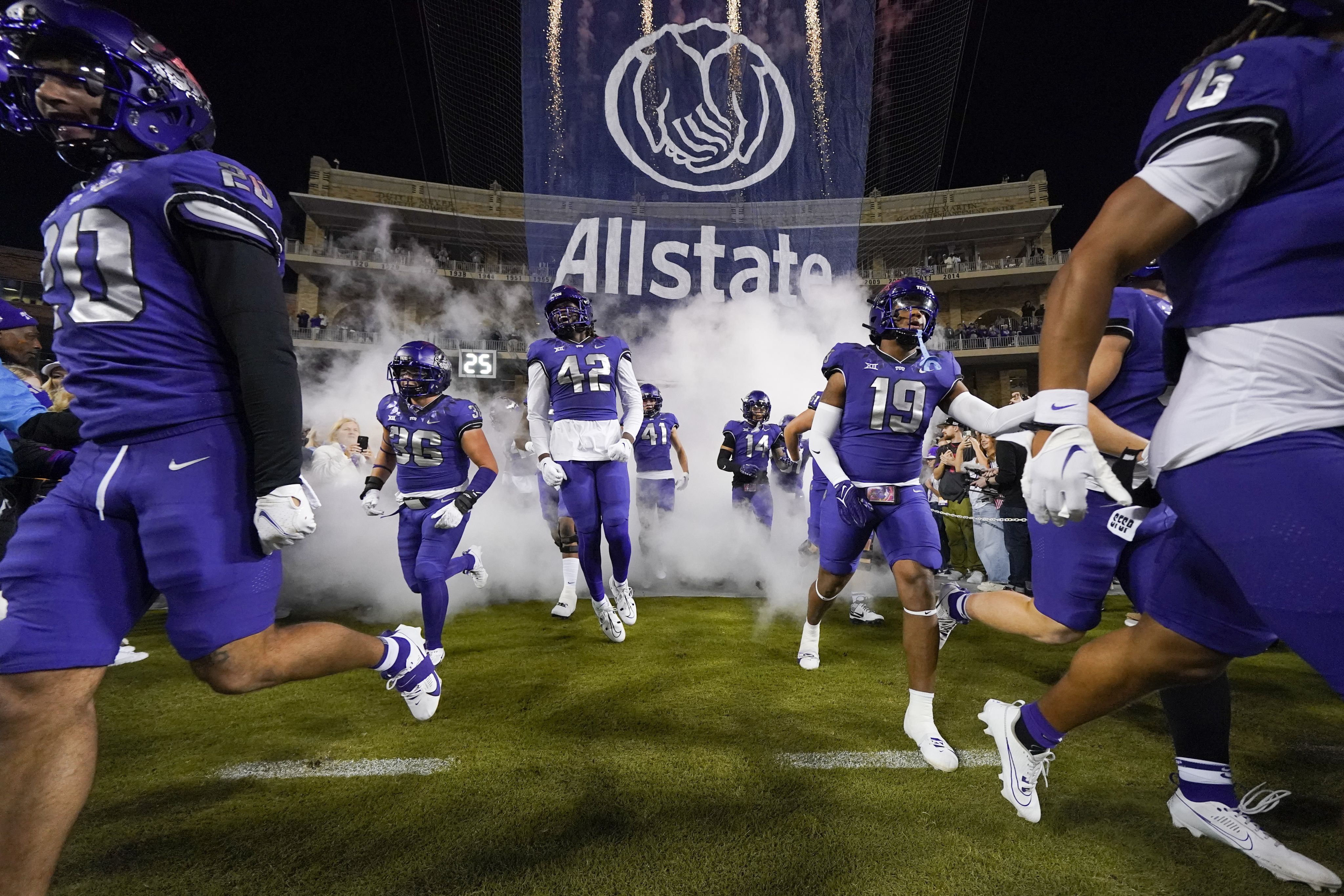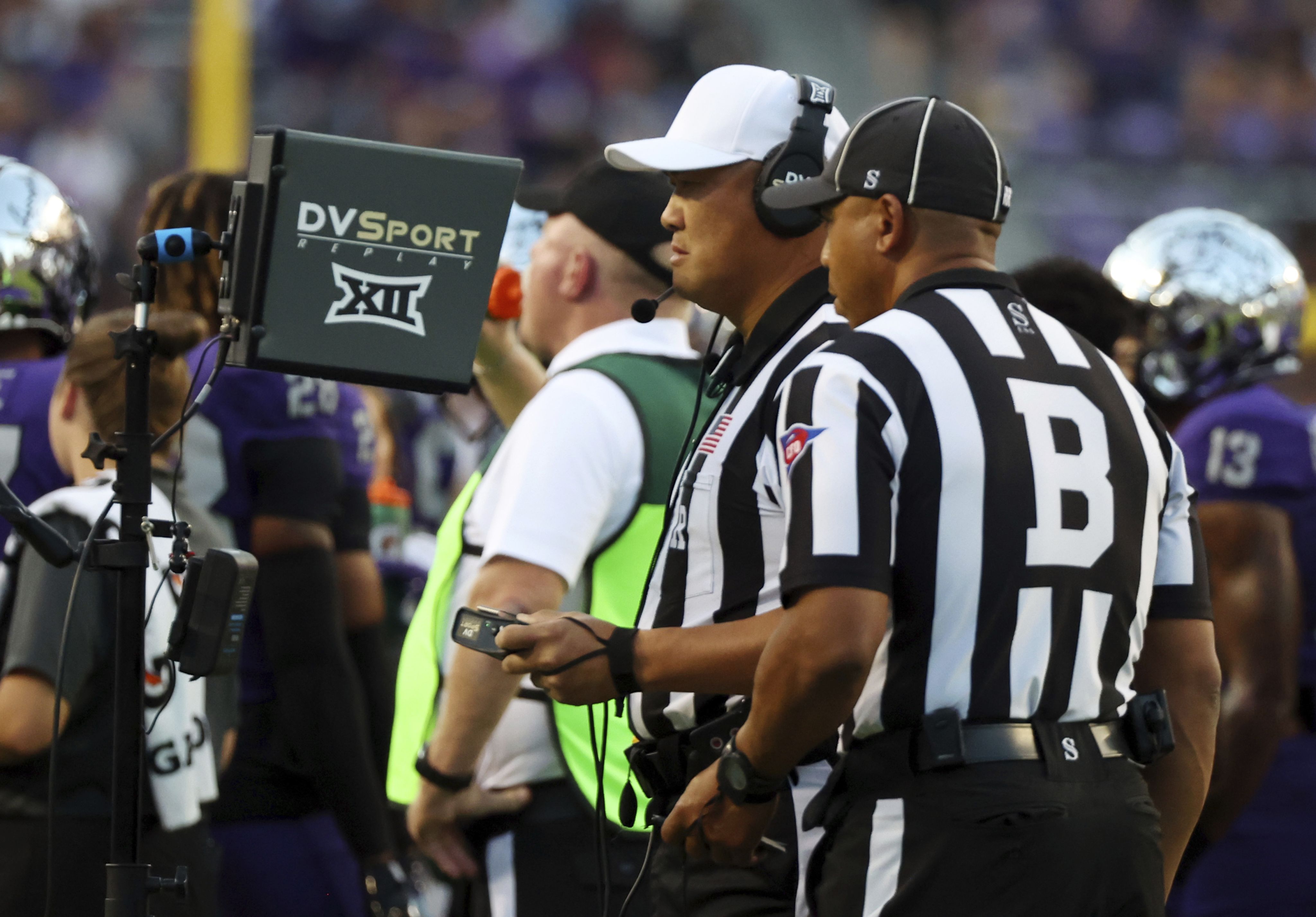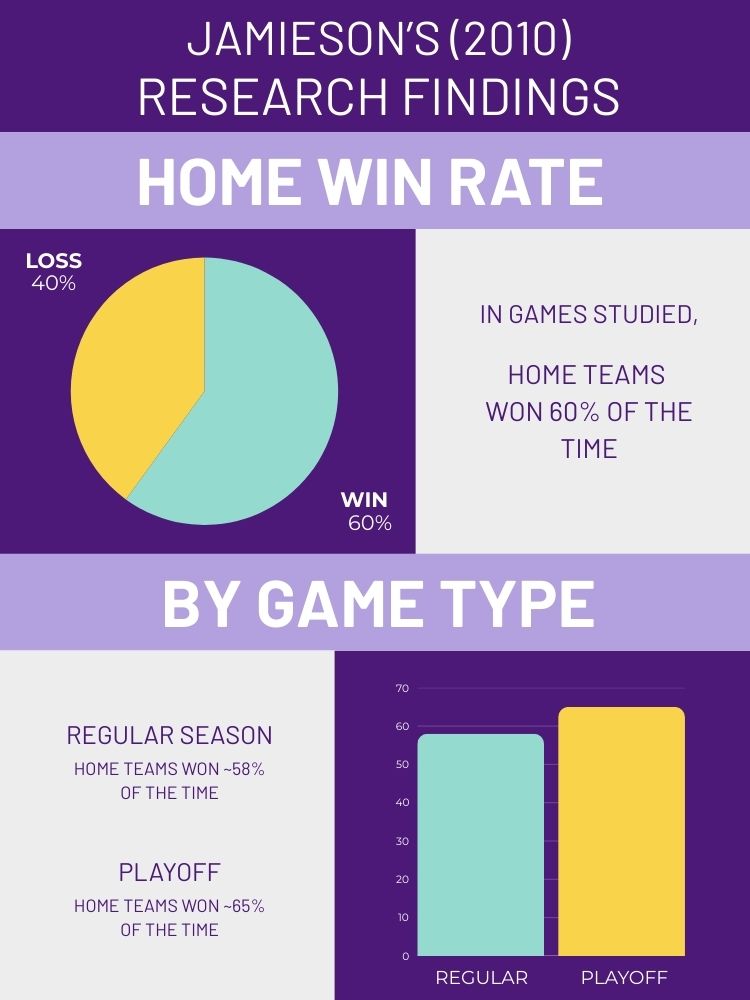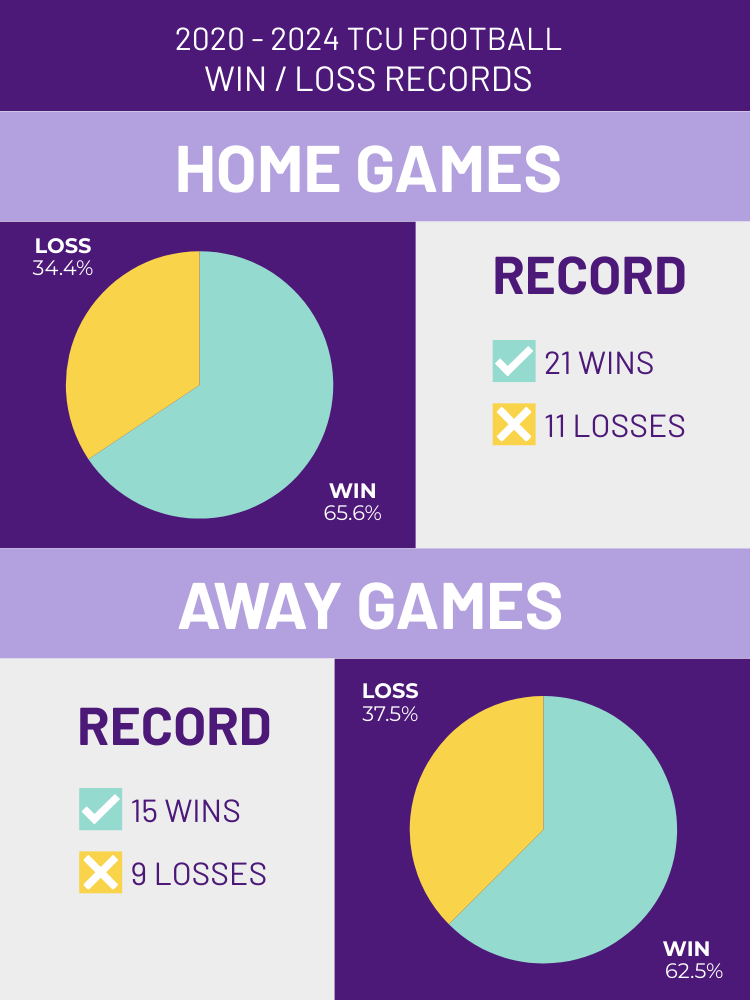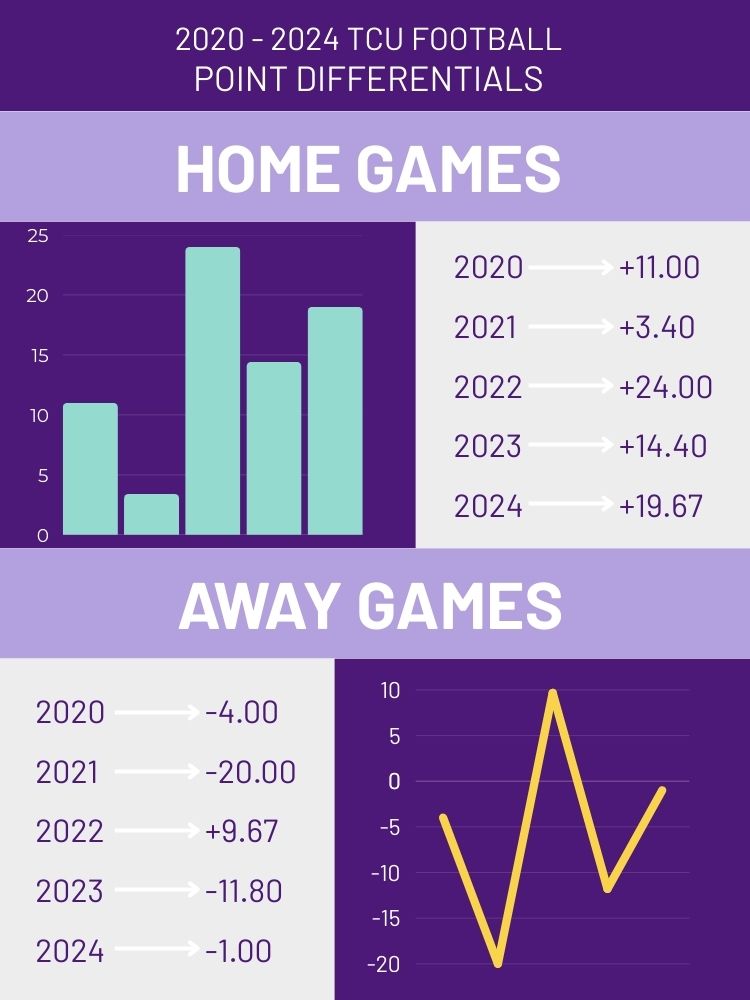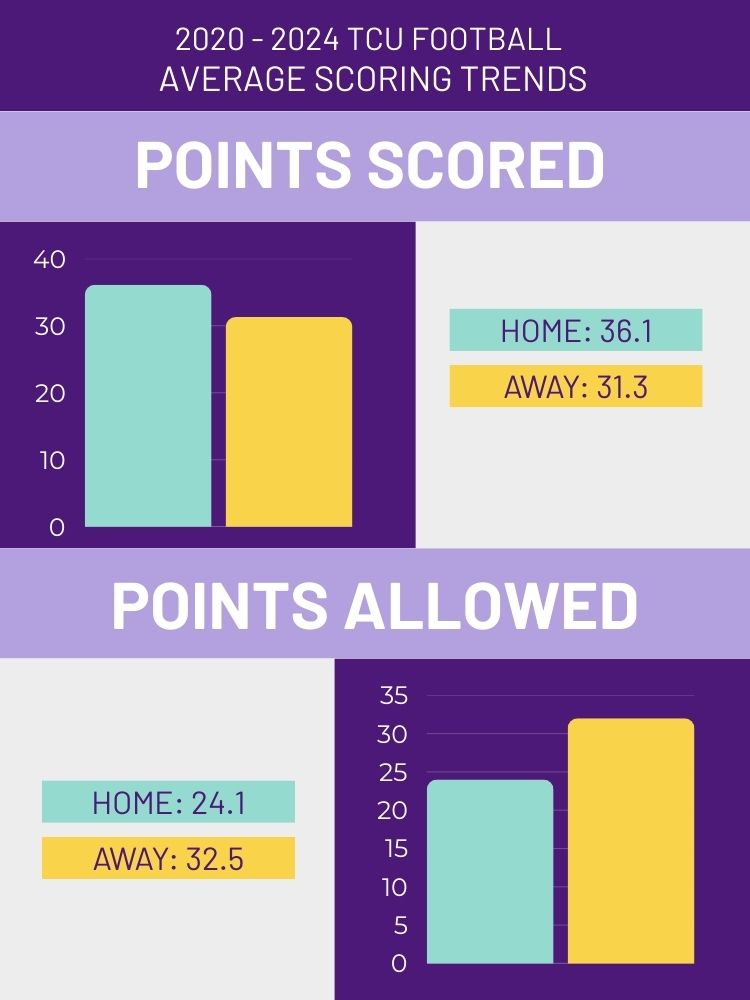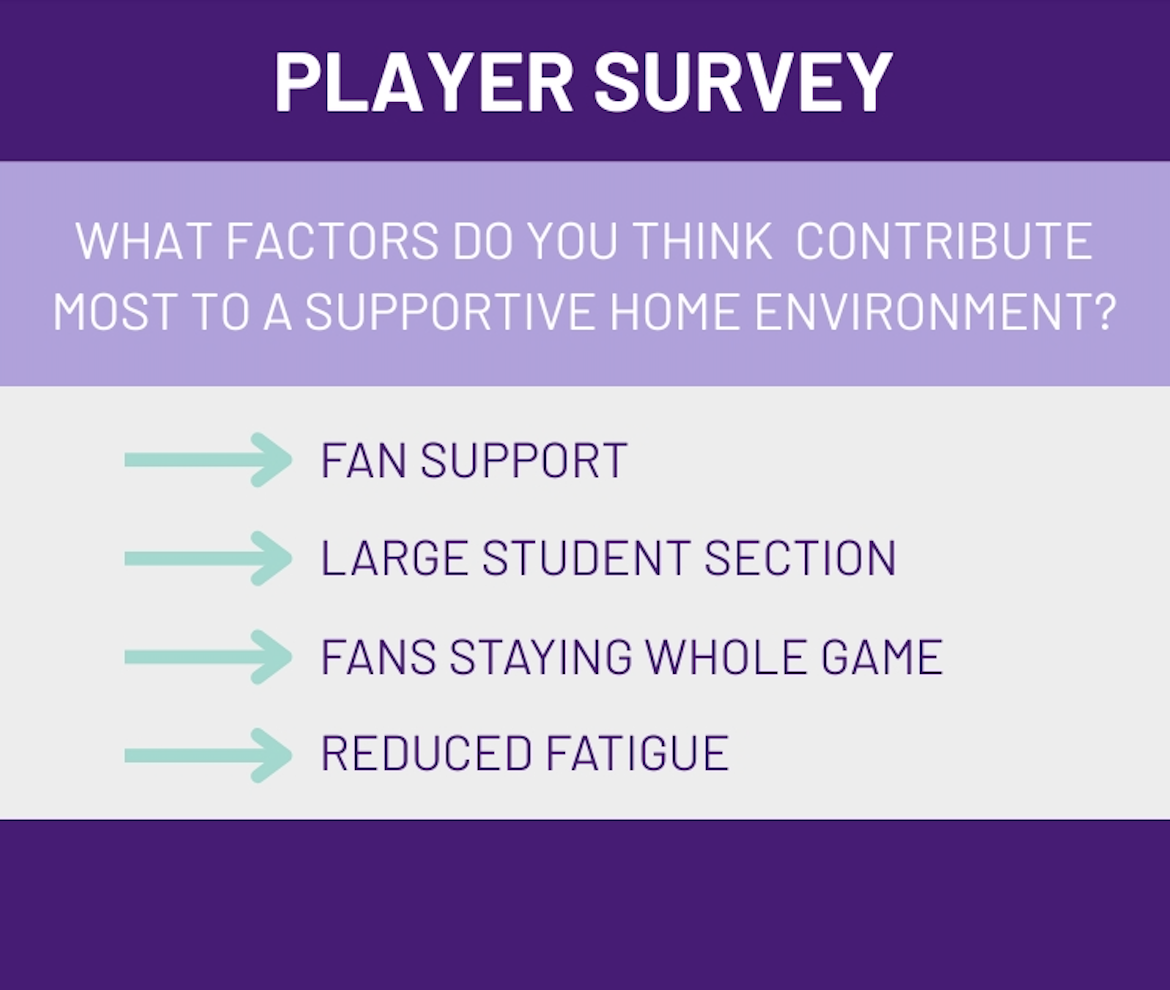HOME-FIELD ADVANTAGE
MYTH OR REALITY AT TCU?
BY: LILLY POOL
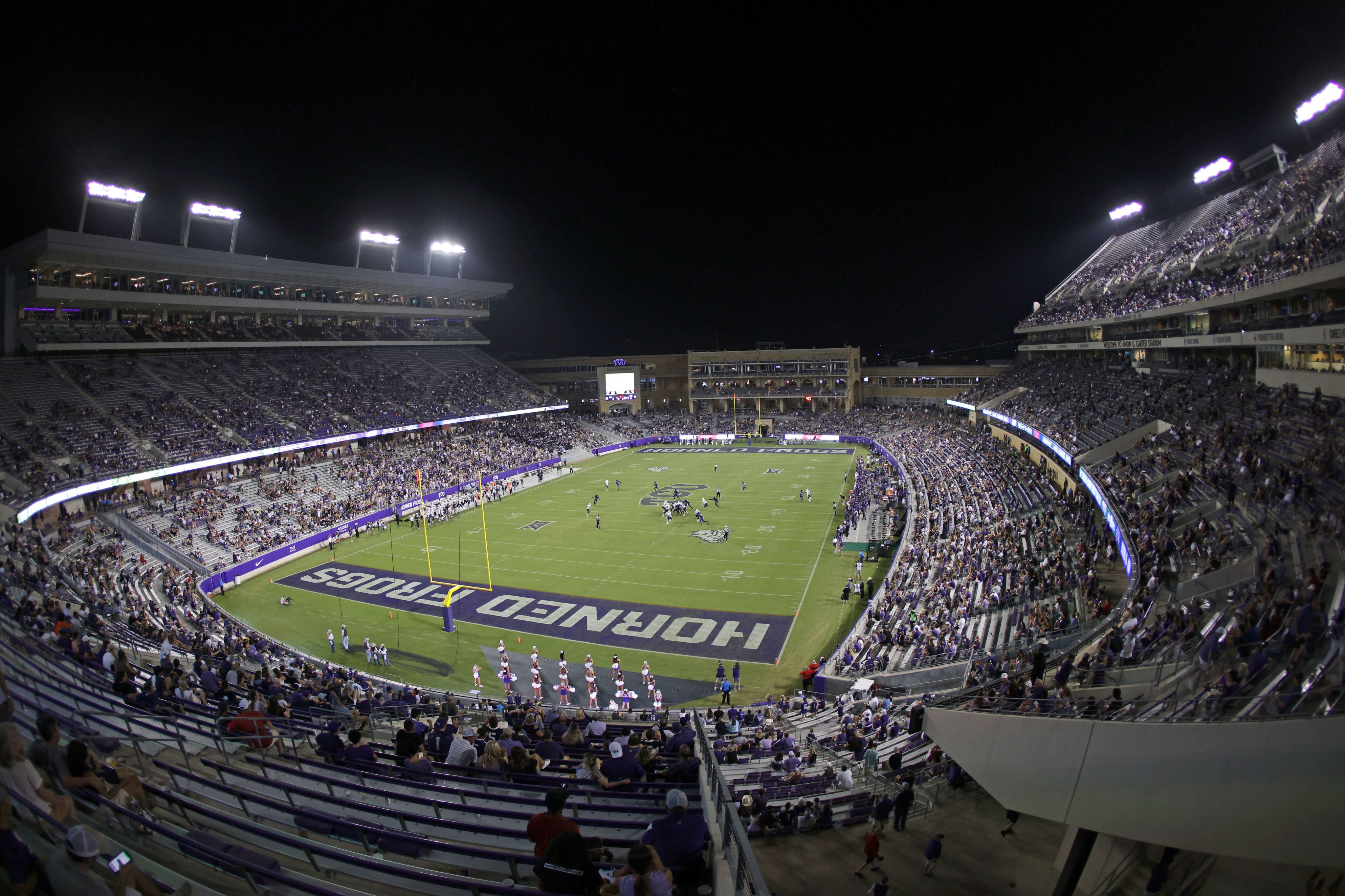
THE WORLD OF COLLEGE FOOTBALL.
A world defined by what seems to be unpredictable. Week after week, year after year, the sport delivers shocking upsets, last-second comebacks and controversial playoff selections that leave fans and analysts alike scrambling.
A team may be favored to win by 20 points, only to fall short in dramatic fashion.
But what drives these outcomes—and what factors influence the odds in the first place?
One common explanation is home-field advantage.
-- the belief that playing on familiar turf, surrounded by loyal fans, gives a team an inherent edge. It's a theory repeated by commentators, embraced by fans, and built into point spreads each week.
The assumption is simple: being at home increases a team's chance of winning.
Despite its widespread acceptance, the actual impact of home-field advantage remains contested. Is it truly a game-changing factor? Or are outcomes primarily shaped by a team’s overall talent, preparation and execution, regardless of where the game is played?
This project explores those questions through an analysis of TCU football's performance over the past five seasons.
Here we will investigate whether home-field advantage is a real and measurable force for the Horned Frogs or if it is just another myth
--in the chaotic landscape of college football.

THERE IS NO PLACE LIKE HOME
-- especially in college football.
Playing at home means stepping onto familiar turf, surrounded by thousands of fans, many of whom were raised to live, breathe and die for their team.
From the crowd's roar to the booming sound systems,
the echo of the band and towering video boards...
home games offer more than just convenience.
THEY CREATE AN ATMOSPHERE.
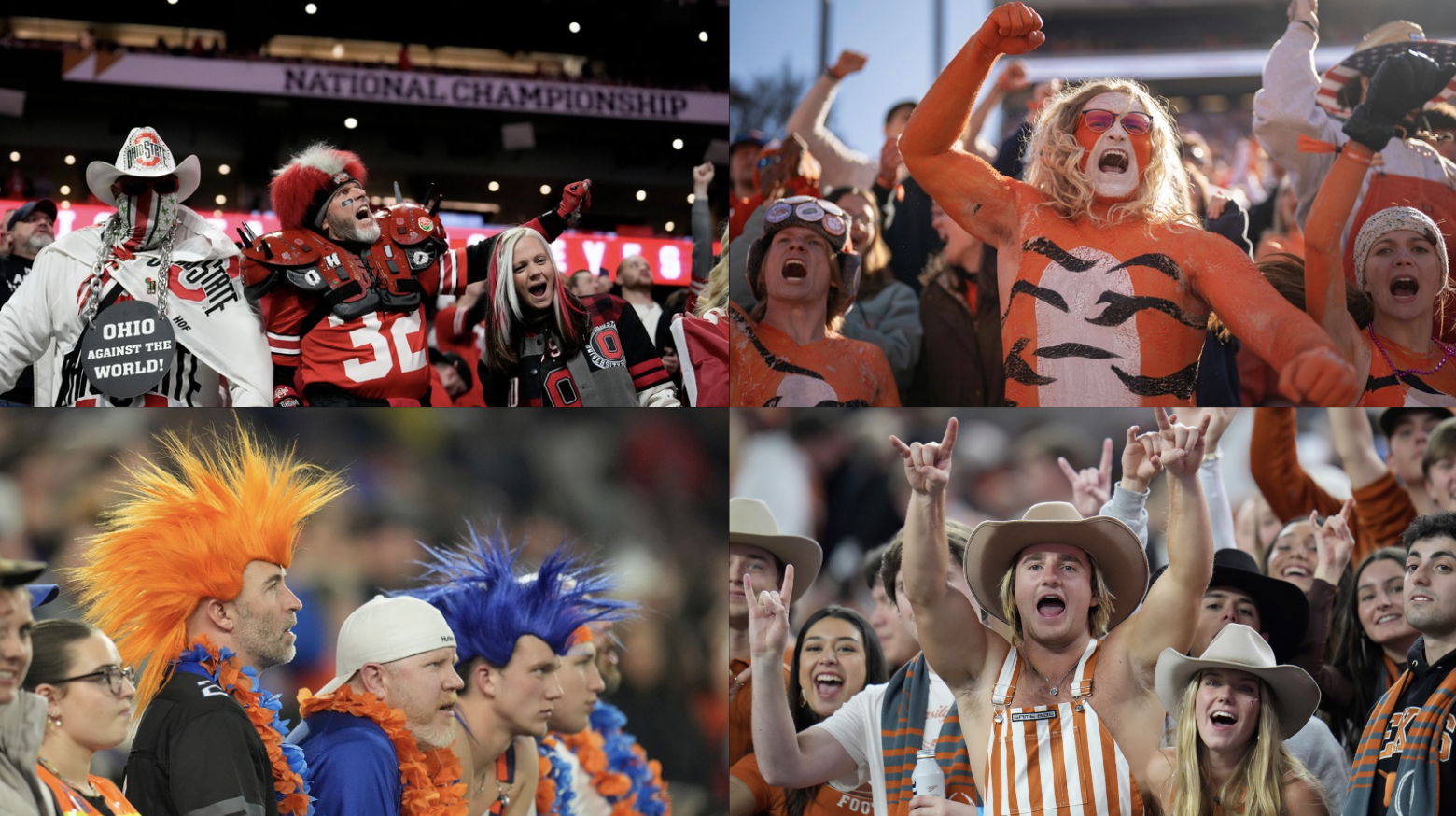
LITERATURE REVIEW
To explain the phenomenon of home-field advantage, researchers have built on Social Facilitation Theory.
Posited by Robert Zajonc in 1965, Social Facilitation Theory suggests that being in the presence of an audience increases ones physiological arousal, meaning the body's heightened state of activity or alertness in response to stimuli.
Zajonc says that when in the heightened state of arousal, the performance of well-learned tasks becomes enhanced.
Collegiate athletes are highly-trained and know the plays like the back of their hand, which, in connection to the theory, suggests that their execution of routine plays in-game will be improved.
Combined, these factors make Social Facilitation Theory a valuable lens for understanding the concept of home-field advantage.

COURNEYA AND CARRON (1992) MODEL
In addition to Social Facilitation Theory, Courneya and Carron (1992) developed a model that has continued to serve as the foundation of research on home-field advantage. Their framework breaks the phenomenon down into four key factors, combining psychological and logistical advantages that visiting teams often struggle to overcome.
CROWD FACTORS
The influence of the home crowd’s presence, size, noise level, and enthusiasm on players, officials, and the overall atmosphere of the game.
TRAVEL FATIGUE
The physical and psychological fatigue experienced by the away team due to travel before the game.
VENUE FAMILIARITY
The home team’s advantage comes from being more accustomed to the playing environment, including the field, locker rooms, lighting, noise, and other surroundings.
OFFICIATING BIAS
The tendency for officials or referees to favor the home team, consciously or not, often due to crowd pressure or psychological influence.
Since the models creation, the nature of competitive sports has evolved, leading researchers to revisit and refine the factors to fit the present dynamic of sports.
In a meta-analysis of home-field advantage across various sports, Jamieson (2010) maintained the credibility of the model's components but added that different contextual factors, such as game type, season length and competition level, can influence it.
Jamieson's research found a correlation between playing at home and team success, with home teams winning approximately 60% of the time.
In addition, he found that in higher-stakes games, such as playoffs, home teams won approximately 65% of the time.
These results emphasize that while the factors of Courneya and Carron's model remain relevant, their impact is not universal, and home-field advantage should be understood as a context-dependent phenomenon.
METHODOLOGY
-- Building off of the conclusion that home-field advantage is a context-dependant phenomenon.
The primary method used in this study was quantitative data analysis to evaluate whether playing at home significantly impacts the performance of the TCU football team, or if success is more strongly influenced by overall team strength.
The analysis includes data from the last five football seasons (2020–2024), with neutral site game data eliminated, focusing on win-loss records, point differentials, scoring trends and game attendance.
To further understand how playing at home impacts those on the field, I received insight from TCU football player detailing how he views playing at home versus on the road.
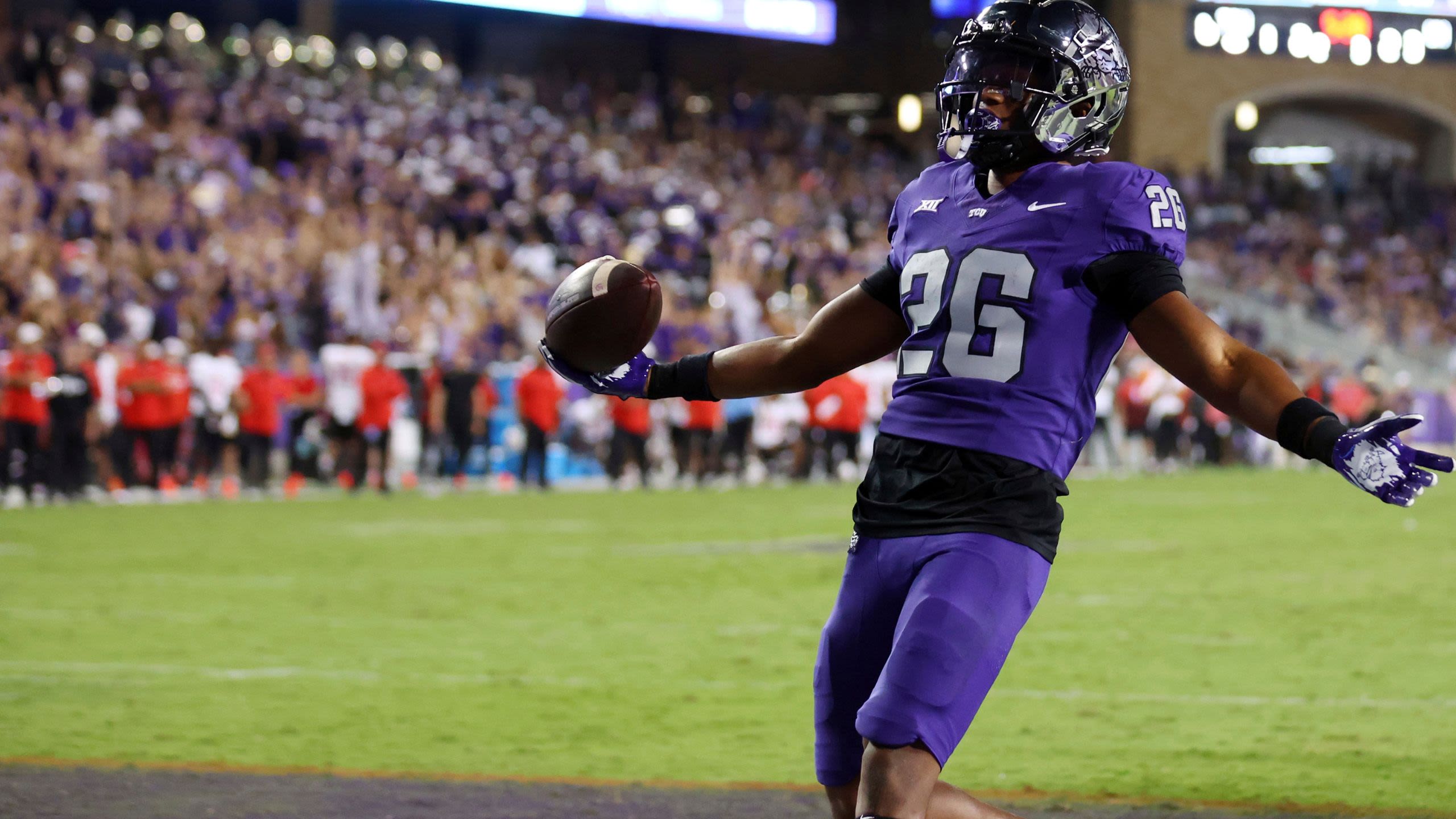
FINDINGS
THE REAL TEST LIES IN THE NUMBERS
Does the familiar field and loyal fans really give TCU an inherent edge? Here, we will see.
For TCU, the last five seasons provided a variety of team performances, ranging from playoff runs to rebuilding years, making it an ideal window to evaluate whether playing at home consistently impacted outcomes.
WIN / LOSS RECORDS AT HOME VS. AWAY
-- The clearest starting data point for determining home-field advantage.
At home in Amon G. Carter Stadium, TCU won 21 out of 32 games, meaning a home win rate of 65.6% across the 2020 to 2024 seasons.
In comparison, the Horned Frogs won 15 out of their 24 games while on the road, leaving a 62.5% win rate.
The difference between these numbers is modest, but it starts to hint that home games might offer a slight advantage.
POINT DIFFERENTIALS
Win percentages offer a basic measure of success, but they don't tell the full story.
Point differentials, the margin by which TCU either won or lost each game, provide deeper insight into not just whether they won or lost, but how decisively they did.
From 2020 to 2024, TCU's average point differential at home was +12.03, while the average point differential for away games was -1.21.
This is a significant gap that supports the presence of home-field advantage.
In seasons where the team performed well overall, like 2022, the effect was even more noticeable, with a home point differential of +24.0 compared to +9.67 on the road.
Even in years with less overall success, such as 2021 and 2023, TCU still posted positive point differentials at home while struggling on the road.
In 2024, this trend continued. TCU’s home games showed a dominant +19.67 average margin, compared to a nearly neutral –1.0 away differential.
These results suggest that while team strength is clearly a factor, playing at home consistently helped TCU perform more decisively, especially when facing more competitive matchups or during less consistent seasons.
SCORING TRENDS
A clear pattern emerges when comparing scoring trends across the 2020–2024 seasons.
TCU consistently performed better offensively and defensively when playing at home.
At The Carter, the Horned Frogs averaged 36.1 points scored per game while allowing 24.1 points.
While on the road, the average points scored per game was 31.3, while points allowed increased to 32.5.
Overall, at home, TCU averaged scoring an additional five points, and an eight-point reduction in points was allowed.
The differences between these averages highlight the Horned Frogs measurable impact while playing on their home turf.
These trends continue to suggest that home-field advantage is prevalent. In the past five seasons, TCU has been controlling the game more effectively on both sides of the ball at home.
ATTENDANCE & ENVIRONMENT
-- A major factor is determining a teams home-field advantage.
While the previous performance metrics analyzed offer direct evidence of TCU performing better at home, attendance of fans in support of the home team plays a large role as well.
A packed stadium is thought to create a louder, more intimidating environment for visiting teams, while, in turn, boosting the confidence of the home team.
Beyond the noise, the crowd can shape momentum and influence energy levels.
In this section, I will discuss how those on the field are impacted by greater attendance.

"PACK THE CARTER"
As much as the fans might feel the difference in an electric home environment, nothing is more important than how it impacts the players and everyone else on the field.
On October 15, 2022, the Horned Frogs were still undefeated. But that day, the game against Oklahoma State started to feel like this streak could end.
Luckily, after a second overtime, Kendre Miller ran it in for a TCU touchdown, keeping the win-streak alive with a 43-40 victory.
In this same game, TCU students set a new attendance record, which Coach Dykes spoke on after the game.
"Everyone stayed and believed in us. I think they were a big part of our victory today," Dykes said.
The players also feel a difference.
On Nov. 26, 2022, the Horned Frogs played their last regular season game, finishing the season out with a perfect 12-0 record, which had only been achieved twice before in 2009 and 1938.
After the 62-14 victory over Iowa State, quarterback Max Duggan commented on the support from fans.
"It helps us, we love when they show out and are loud," Duggan said.
It’s clear that players feed off the energy from the crowd. But where does the crowd get their energy?
Here’s an example — The fan-favorite and beloved Hypnotoad.
What started as a fun addition to TCU’s game day experience quickly turned into a cherished character.
Flashing on the stadium screens during crucial moments, the Hypnotoad became the sign for everyone to get loud, and that it did.
The louder the crowd, the more the players felt it on the field, creating a feedback loop of energy.
A PLAYERS POINT-OF-VIEW
To further understand how playing at home is felt from the field, I surveyed a current football player at TCU.
His responses reflected a balanced but meaningful belief in the value of the home-field advantage.
The player noted that while team strength ultimately determines outcomes, playing at home provides a noticeable boost. He shared that he feels slightly more confident during home games and believes fan support moderately impacts performance.
Specifically, he highlighted several elements that create an ideal home atmosphere: a large student section, crowd noise, fans staying for the whole game and reduced fatigue from not having to travel.
Although he acknowledged that the most significant factor in winning is the team’s overall ability, he agreed that playing at The Carter offers a competitive edge.
This perspective mirrors key aspects of Courneya and Carron's (1992) model, reinforcing the relevance of both psychological comfort and external support in shaping home-field advantage from an athlete’s point of view.
CONCLUSION
The numbers show it. The players feel it. The fans help create it.
Although it might not be the all-powerful factor, these findings from the past five seasons can conclude that home-field advantage at TCU is real.
At Amon G. Carter Stadium, the Horned Frogs won by wider margins and played more balanced football on both sides. With the higher win percentages, the point differentials are different, and scoring trends are confirmed. The advantage of home turf at TCU is proven.
In seasons like 2022, playing at home helped elevate a great team into something dominant.
However, what stood out most was the emotions evoked from those on the field during home games.
The players' stories and perspectives emphasized the statistics; being at home gave them an extra boost of confidence and fuel.
Ultimately, home-field advantage at TCU isn't just about being at home; it's about what that home represents: comfort, support, tradition, and pride. In the right season, it can be the difference between a good team and an unforgettable one.
There is no greater atmosphere than one surrounded by fans, fueled by tradition and grounded in routine.
--especially in the chaotic landscape of college football.
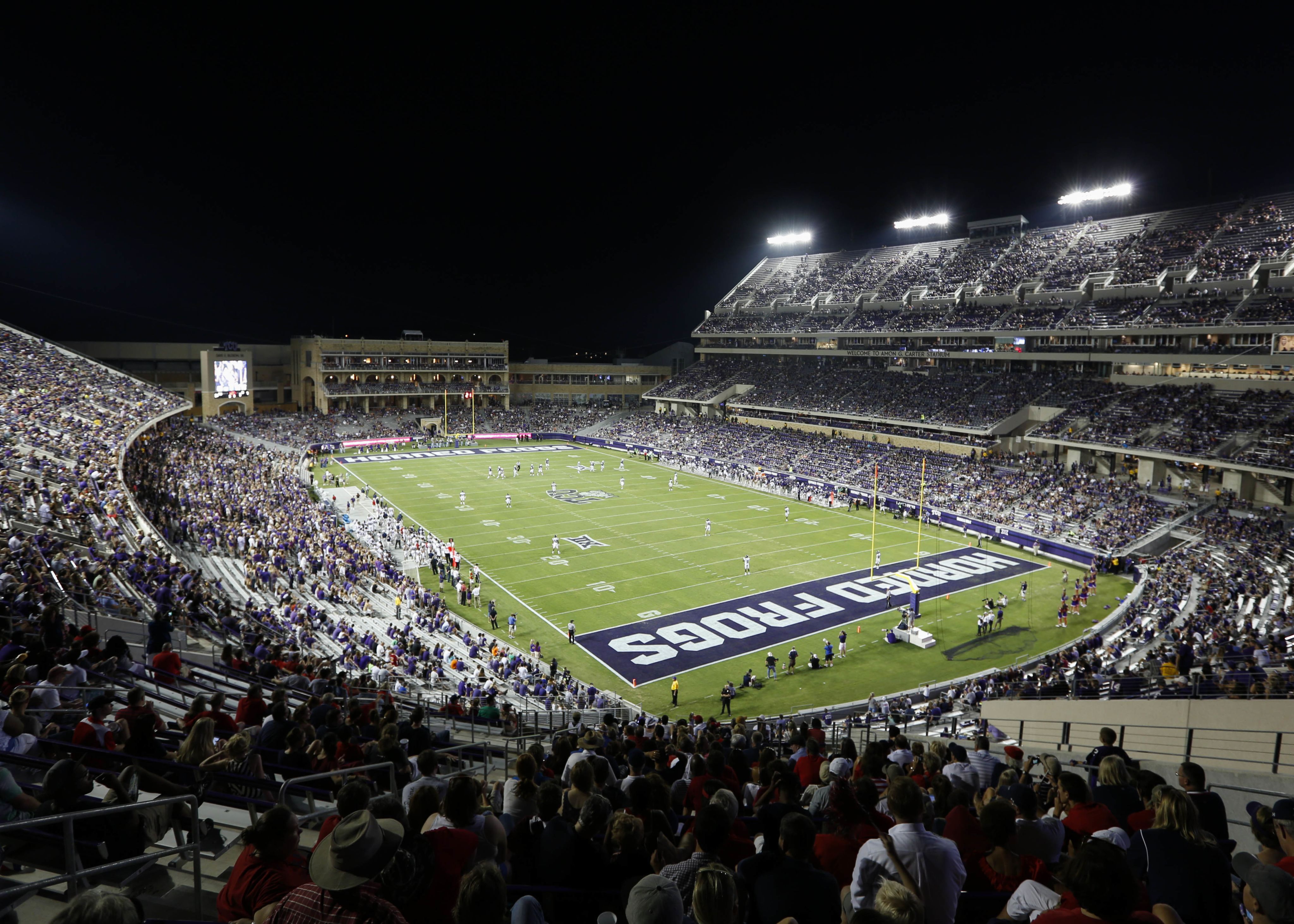
REFERENCES
Courneya, K. S., & Carron, A. V. (1992). The Home Advantage In Sport Competitions: A Literature Review. Journal of Sport & Exercise Psychology, 14(1), 13–27. https://doi.org/10.1123/jsep.14.1.13
Jamieson, J. P. (2010). The Home Field Advantage in Athletics: A Meta-Analysis. Journal of Applied Social Psychology, 40(7), 1819–1848. https://doi.org/10.1111/j.1559-1816.2010.00641.x
Meissner, S. (1994). Components of social facilitation, home field advantage, and home field disadvantage and their effects on sport performance. ProQuest Dissertations & Theses.
TCU Athletics. (2022, October 15). Postgame quotes: Football vs. Oklahoma State. GoFrogs.com. https://gofrogs.com/news/2022/10/15/football-postgame-quotes.aspx
TCU Athletics. (2022, November 26). Postgame notes: Football vs. Iowa State. GoFrogs.com. https://gofrogs.com/news/2022/11/26/football-postgame-notes.aspx
All photo credit: AP Photo, https://newsroom.ap.org/

